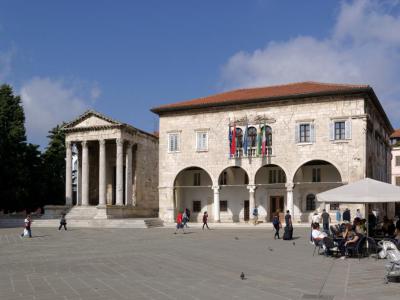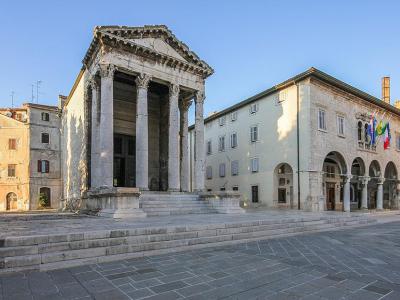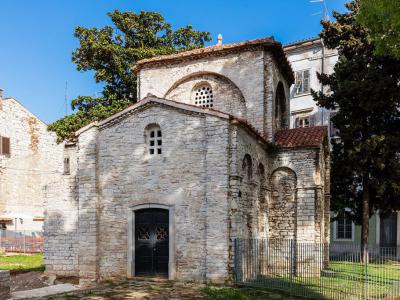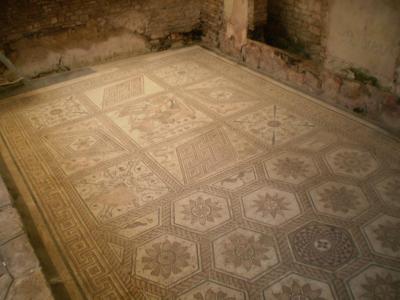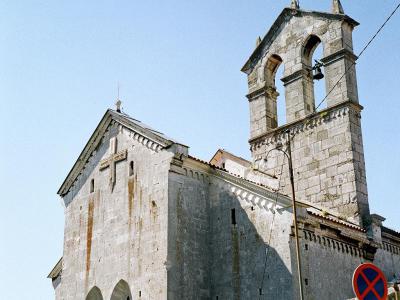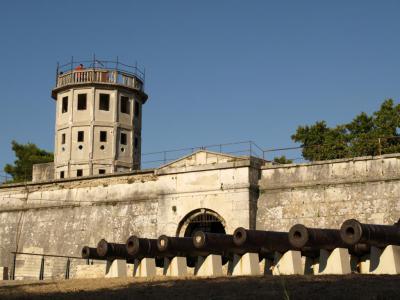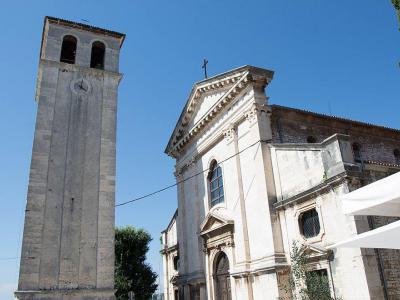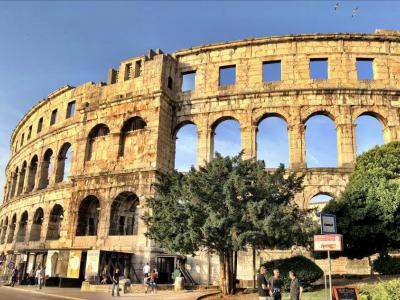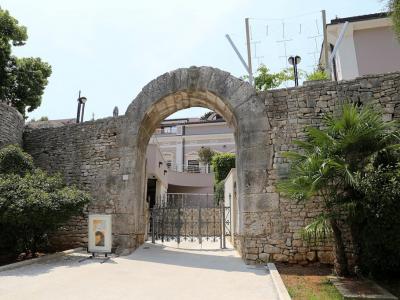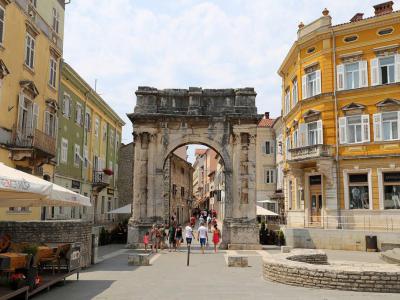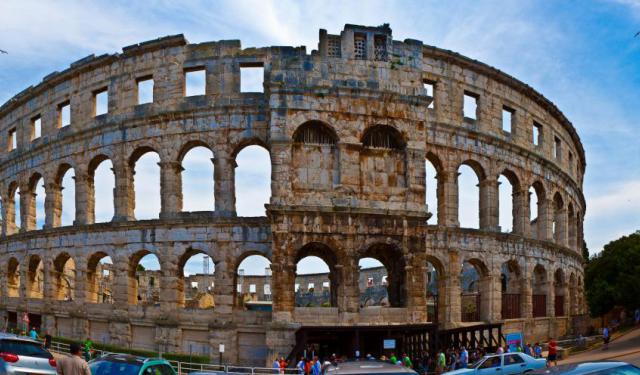
Pula Introduction Walking Tour (Self Guided), Pula
Greek mythology attributed the foundation of the city of Polai, known as Pula today, to the Colchians. In the story of Jason and Medea, it is said that Jason seduced Medea, the Witch of Colchis. He then escaped with her and the Golden Fleece. The unlucky Colchians chased them into the Adriatic. They lost them and being lost themselves, they settled in Polai which they called a "Place of Refuge."
The Romans came to visit in 177 BC. During the civil war of 42 BC between the alliance of Brutus and Cassius vs the alliance of Antony, Octavian and Lepidus, Pula had to pick a side. Pula chose Brutus and Cassius. Bad idea. Brutus and Cassius lost. Octavian demolished Pula.
Oadacer, the Ostrogoths, the Byzantines, the Franks, and the Venetians took turns conquering Pula. Genoa and Venice struggled for control of the city until 1331. Venice prevailed. They would rule in Pula until 1797. With the collapse of the Venetian Republic, Pula became a part of Austria-Hungary until the end of World War I.
Today, Pula is a part of the Republic of Croatia. The city is bilingual, the citizens speak both Italian and Croatian. It nestles beneath seven hills on the Istrian Peninsula in the Adriatic Sea.
Its ambience is more urban and international. Its architecture is a mix of Roman, Venetian, Hungarian and Socialist Post-Modern.
The most well-known attraction is the Roman colosseum. Well-preserved, it dates back to the 1st century AD. The Arch of Triumph from the 1st century Ad, once part of the city walls, now stands alone. The Roman forum still has the remains of five ancient temples.
There are 26 Austro-Hungarian forts and batteries. They house Pula's Aquarium. Fort Punta Christo and Fort Verudela are venues for music festivals. Churches include the Byzantine Chapel Of Santa Maria, the Benedictine Abbey, the Pula Cathedral and St. Mark's Basilica.
The clear blue waters of the Adriatic and the surrounding countryside of Pula have made the city an attractive summer destination. The coastal waters offer beaches, fishing and sailing to unspoiled mysterious islands. Dinosaur footprints have been found on some of the beaches.
Visit Pula. Walk in the footsteps of Romans, Gladiators, Venetians and Dinosaurs.
The Romans came to visit in 177 BC. During the civil war of 42 BC between the alliance of Brutus and Cassius vs the alliance of Antony, Octavian and Lepidus, Pula had to pick a side. Pula chose Brutus and Cassius. Bad idea. Brutus and Cassius lost. Octavian demolished Pula.
Oadacer, the Ostrogoths, the Byzantines, the Franks, and the Venetians took turns conquering Pula. Genoa and Venice struggled for control of the city until 1331. Venice prevailed. They would rule in Pula until 1797. With the collapse of the Venetian Republic, Pula became a part of Austria-Hungary until the end of World War I.
Today, Pula is a part of the Republic of Croatia. The city is bilingual, the citizens speak both Italian and Croatian. It nestles beneath seven hills on the Istrian Peninsula in the Adriatic Sea.
Its ambience is more urban and international. Its architecture is a mix of Roman, Venetian, Hungarian and Socialist Post-Modern.
The most well-known attraction is the Roman colosseum. Well-preserved, it dates back to the 1st century AD. The Arch of Triumph from the 1st century Ad, once part of the city walls, now stands alone. The Roman forum still has the remains of five ancient temples.
There are 26 Austro-Hungarian forts and batteries. They house Pula's Aquarium. Fort Punta Christo and Fort Verudela are venues for music festivals. Churches include the Byzantine Chapel Of Santa Maria, the Benedictine Abbey, the Pula Cathedral and St. Mark's Basilica.
The clear blue waters of the Adriatic and the surrounding countryside of Pula have made the city an attractive summer destination. The coastal waters offer beaches, fishing and sailing to unspoiled mysterious islands. Dinosaur footprints have been found on some of the beaches.
Visit Pula. Walk in the footsteps of Romans, Gladiators, Venetians and Dinosaurs.
How it works: Download the app "GPSmyCity: Walks in 1K+ Cities" from Apple App Store or Google Play Store to your mobile phone or tablet. The app turns your mobile device into a personal tour guide and its built-in GPS navigation functions guide you from one tour stop to next. The app works offline, so no data plan is needed when traveling abroad.
Pula Introduction Walking Tour Map
Guide Name: Pula Introduction Walking Tour
Guide Location: Croatia » Pula (See other walking tours in Pula)
Guide Type: Self-guided Walking Tour (Sightseeing)
# of Attractions: 12
Tour Duration: 2 Hour(s)
Travel Distance: 2.7 Km or 1.7 Miles
Author: Cathy
Sight(s) Featured in This Guide:
Guide Location: Croatia » Pula (See other walking tours in Pula)
Guide Type: Self-guided Walking Tour (Sightseeing)
# of Attractions: 12
Tour Duration: 2 Hour(s)
Travel Distance: 2.7 Km or 1.7 Miles
Author: Cathy
Sight(s) Featured in This Guide:
- Forum Square and Communal Palace
- Temple of Augustus
- Chapel of Saint Maria Formose
- Floor Mosaic The Punishment of Dirce
- Franciscan Church and Monastery
- Pula Castle (Kastel)
- Pula Cathedral
- Roman Amphitheater (Pula Arena)
- Twin Gates (Porta Gemina)
- Gate of Hercules (Herkulova Vrata)
- Small Roman Theatre
- Triumphal Arch of the Sergii
1) Forum Square and Communal Palace (must see)
The history of Pula is in its main square, the Forum Square. Pula was officially founded in 44 BC by one Cassius Longinus, brother to the infamous Cassius, assassin of Julius Caesar and by Lucius Calpurnius Piso, Julius Caesar's father-in-law.
The forum of Pula was a venue for public events, politics, religion, and commerce. The square originally measured 128 feet (39 meters) by 269 feet (82 meters). In the north side of the forum were temples dedicated to the Roman gods Jupiter, Juno and Minerva.
Only the temple of Augustus from about 14 AD has been perfectly preserved. Parts of the other temples may be found in the back wall of the Communal Palace, built in the 13th century. The Pula Forum continued to be the town's main square throughout the middle ages.
In the Venetian era, the Communal Palace replaced the temples of the gods. It would be used as the governmental center. The Temple of Diana had served as a town hall since the 9th century. The core date of the Communal Palace is 1296, the time when Pula became a free municipality. The Palace remains the seat of government today.
The structure of the Palace shows a mixture of styles. The east walls show combined Romanesque and Gothic elements. The sculptures of Telemon and Siren in corners flanked by Renaissance columns and Baroque windows mark the latest changes to the Communal Palace. Having been neglected for centuries, the Palace is now restored and it is today a popular tourist attraction.
The forum of Pula was a venue for public events, politics, religion, and commerce. The square originally measured 128 feet (39 meters) by 269 feet (82 meters). In the north side of the forum were temples dedicated to the Roman gods Jupiter, Juno and Minerva.
Only the temple of Augustus from about 14 AD has been perfectly preserved. Parts of the other temples may be found in the back wall of the Communal Palace, built in the 13th century. The Pula Forum continued to be the town's main square throughout the middle ages.
In the Venetian era, the Communal Palace replaced the temples of the gods. It would be used as the governmental center. The Temple of Diana had served as a town hall since the 9th century. The core date of the Communal Palace is 1296, the time when Pula became a free municipality. The Palace remains the seat of government today.
The structure of the Palace shows a mixture of styles. The east walls show combined Romanesque and Gothic elements. The sculptures of Telemon and Siren in corners flanked by Renaissance columns and Baroque windows mark the latest changes to the Communal Palace. Having been neglected for centuries, the Palace is now restored and it is today a popular tourist attraction.
2) Temple of Augustus (must see)
Sitting next to the Communal Palace in the Forum Square of Pula, is the Temple of Augustus. "To Rome and Augustus Caesar, son of the deity, father of the fatherland", the sign once hammered into the temple walls said. Augustus had been a god. Only the nail holes of the bronze sign remain.
Augustus had to wait until after his death in AD 15 to be diefied. The temple was actually built in 2 AD. The building is lavishly decorated. It is built on a podium with a tetrastyle prostyle porch having Corinthian columns with friezes. The overall dimensions are 26 feet by 57 feet in area and 46 feet in height.
The temple originally was one of three. It was located on the left side of the main central temple. The Temple of Diana stood on the opposite side. The main temple has not survived intact, while the back wall of the Temple of Diana was incorporated into the Communal Palace, built in 1296.
The temple of Augustus was closed after the persecution of pagans began in the 4th century. When Pula came under Byzantine rule in the 8th century, the temple was converted into a church dedicated to Mary. In the 17th century, under Venetian rule, the temple was incorporated into a complex of neighboring buildings on the square.
The interior of the temple is a small museum of tombstones and Roman sculptures. These were discovered during excavations of the colony Pietas Lulia, by Napoleonic General Auguste de Marmont, governor of the Illyrian Provinces. Traces of frescoes can be seen on the interior walls.
The Temple today is a lapidarium. For a good look at Pula's Roman beginnings, this is a main destination.
Augustus had to wait until after his death in AD 15 to be diefied. The temple was actually built in 2 AD. The building is lavishly decorated. It is built on a podium with a tetrastyle prostyle porch having Corinthian columns with friezes. The overall dimensions are 26 feet by 57 feet in area and 46 feet in height.
The temple originally was one of three. It was located on the left side of the main central temple. The Temple of Diana stood on the opposite side. The main temple has not survived intact, while the back wall of the Temple of Diana was incorporated into the Communal Palace, built in 1296.
The temple of Augustus was closed after the persecution of pagans began in the 4th century. When Pula came under Byzantine rule in the 8th century, the temple was converted into a church dedicated to Mary. In the 17th century, under Venetian rule, the temple was incorporated into a complex of neighboring buildings on the square.
The interior of the temple is a small museum of tombstones and Roman sculptures. These were discovered during excavations of the colony Pietas Lulia, by Napoleonic General Auguste de Marmont, governor of the Illyrian Provinces. Traces of frescoes can be seen on the interior walls.
The Temple today is a lapidarium. For a good look at Pula's Roman beginnings, this is a main destination.
3) Chapel of Saint Maria Formose
Saint Mary Formose, a basilica, dates from the 6th century. While it is an early Christian monument, only the south chapel, shaped like a Greek cross, remains today. The chapel is an important example of Byzantine architecture in Istria. It was ordered by Archbishop Maximianus of Ravenna.
The original basilica had three naves divided by columns. This effect was echoed in the exterior perimeter walls, windows and blind arches. The sanctuary had three polygonal arches and two side chapels. Of these, only the south chapel is fully preserved today. Most of the north chapel has been absorbed into residences close by.
The exterior is plain, with shallow pilasters, blind arches and half-circle windows. In 1605, when the Venetians raided Pula, they carried off many precious items, including alabaster pilasters which now stand behind the high altar of Saint Mark's Basilica in Venice.
The original basilica had three naves divided by columns. This effect was echoed in the exterior perimeter walls, windows and blind arches. The sanctuary had three polygonal arches and two side chapels. Of these, only the south chapel is fully preserved today. Most of the north chapel has been absorbed into residences close by.
The exterior is plain, with shallow pilasters, blind arches and half-circle windows. In 1605, when the Venetians raided Pula, they carried off many precious items, including alabaster pilasters which now stand behind the high altar of Saint Mark's Basilica in Venice.
4) Floor Mosaic The Punishment of Dirce
Cleaning up after a bombing of World War II, one never knows what one will find. No one expected the Punishment of Dirce. But there it was, a floor mosaic, perfectly preserved. It had been buried for more than a thousand years. It measured 20 by 40 feet. It had been part of a Roman villa, a choice property in its day.
The mosaic tells the story of Dirce. It's not complicated. Dirce was the second wife of King Likos. Dirce was obsessively jealous of the king's first wife, Antiope. Whether Likos divorced Antiope or he just liked having two wives is not clear. At any rate, Dirce tried to jail Antiope. Along came Atiope's twin sons Amfion and Zetos.
It happened that the twins were sired by Zeus. Likos was unaware of this. Amfion and Zetos killed Likos and they really came down hard on Dirce. They arranged to have a bull trample her on the rocks. The story is told in panels. Most of the panels are geometric designs of creatures and leaves. The crucial panel shows the full bull story.
Illustrations of the death of Dirce are rarely happened upon. The mosaic is beautifully crafted. There is a similar story of Dirce in the Vatican Museum. It is a painting of the same bull, the same girl and the same nasty twins.
The mosaic tells the story of Dirce. It's not complicated. Dirce was the second wife of King Likos. Dirce was obsessively jealous of the king's first wife, Antiope. Whether Likos divorced Antiope or he just liked having two wives is not clear. At any rate, Dirce tried to jail Antiope. Along came Atiope's twin sons Amfion and Zetos.
It happened that the twins were sired by Zeus. Likos was unaware of this. Amfion and Zetos killed Likos and they really came down hard on Dirce. They arranged to have a bull trample her on the rocks. The story is told in panels. Most of the panels are geometric designs of creatures and leaves. The crucial panel shows the full bull story.
Illustrations of the death of Dirce are rarely happened upon. The mosaic is beautifully crafted. There is a similar story of Dirce in the Vatican Museum. It is a painting of the same bull, the same girl and the same nasty twins.
5) Franciscan Church and Monastery (must see)
In 1209, Pope Innocent III, a firm believer that the papacy was the political Sun and everything else was not, gave his consent for the newly formed Franciscan order to set up shop in the town of Pula. The Franciscans eventually established a church and monastery on the western slope of Pula hill, below the fortress and above the Forum.
Several dates are given for the construction of the church, ranging from 1291 to 1314. It was completed by Jacobus de Pola, a Franciscan Brother and architect. He is believed to have also had a hand in the design of the Communal Palace of Pula.
The style of the church is Romanesque with Gothic accents. The design follows the architectural Narbonne rules of 1260. The floor plan is rectangular. The sanctuary is square. There is a single-walled bell tower looming over the roof. There is a connecting cloister, a hall, a refectory and sacristy joining the monastery and choir.
In keeping with the views of a mendicant order, the buildings were simple, nothing fancy and skillfully made. On the main altar is a gilded 15th century polyptych. The center panel holds a high relief of the Virgin Mary and Christ. Twelve disciples are depicted surrounding the center. Gothic phials are at the ends of the piece.
The monastery cloister has Renaissance pillars. In the front of the church is a lapidarium with a collection of wall paintings and medieval monuments. Buried in the Church are the remains of Blessed Otto. He arrived in Pula around 1235. He is credited with many miraculous healings. He died in 1241. He is venerated in Pula to this day.
Several dates are given for the construction of the church, ranging from 1291 to 1314. It was completed by Jacobus de Pola, a Franciscan Brother and architect. He is believed to have also had a hand in the design of the Communal Palace of Pula.
The style of the church is Romanesque with Gothic accents. The design follows the architectural Narbonne rules of 1260. The floor plan is rectangular. The sanctuary is square. There is a single-walled bell tower looming over the roof. There is a connecting cloister, a hall, a refectory and sacristy joining the monastery and choir.
In keeping with the views of a mendicant order, the buildings were simple, nothing fancy and skillfully made. On the main altar is a gilded 15th century polyptych. The center panel holds a high relief of the Virgin Mary and Christ. Twelve disciples are depicted surrounding the center. Gothic phials are at the ends of the piece.
The monastery cloister has Renaissance pillars. In the front of the church is a lapidarium with a collection of wall paintings and medieval monuments. Buried in the Church are the remains of Blessed Otto. He arrived in Pula around 1235. He is credited with many miraculous healings. He died in 1241. He is venerated in Pula to this day.
6) Pula Castle (Kastel) (must see)
In its history, Pula has been attacked many times. Before the Roman era, the indigenous Istrian people had defensive fortifications. The Venetians established their fortifications in the same place where the ancient Istrians had theirs; on the hill in the center of Pula. The perfect place for the defense of the city and the bay.
Pula Castle ("Kastel") was built in the period 1630-1633. The designs were by French military architect and engineer, Antonio De Villa. Stones from the old Roman amphitheater were used in its construction in addition to stones from local quarries.
Seen from above, the fort has a blossom shape. The center is rectangular with four pentagonal towers for more effective defensive fire power. The castle was part of Pula's extensive fortification system. During the Austro-Hungarian era the castle was called Hafen Kastell. It became an armory, a prison, and barracks.
The historical and Maritime Museum of Istria is housed in the Baroque 16th century fortress. The museum has more than 100,000 exhibits. The collections include numismatics, photographs and equipment, graphics, maps, postcards, and documents, all involved with the sea and shipbuilding.
There are thousands of 19th century postcards including 1,500 with maritime and naval scenes and sailors' lives and work. In the Maritime History Department, shipbuilding exhibits and items salvaged from wrecks by divers are shown. A reconstruction of the 19th century Royal Hospital and exhibits of pharmaceutical history can be seen.
The Castle offers a rich sampling of history and spectacular views of the city below.
Pula Castle ("Kastel") was built in the period 1630-1633. The designs were by French military architect and engineer, Antonio De Villa. Stones from the old Roman amphitheater were used in its construction in addition to stones from local quarries.
Seen from above, the fort has a blossom shape. The center is rectangular with four pentagonal towers for more effective defensive fire power. The castle was part of Pula's extensive fortification system. During the Austro-Hungarian era the castle was called Hafen Kastell. It became an armory, a prison, and barracks.
The historical and Maritime Museum of Istria is housed in the Baroque 16th century fortress. The museum has more than 100,000 exhibits. The collections include numismatics, photographs and equipment, graphics, maps, postcards, and documents, all involved with the sea and shipbuilding.
There are thousands of 19th century postcards including 1,500 with maritime and naval scenes and sailors' lives and work. In the Maritime History Department, shipbuilding exhibits and items salvaged from wrecks by divers are shown. A reconstruction of the 19th century Royal Hospital and exhibits of pharmaceutical history can be seen.
The Castle offers a rich sampling of history and spectacular views of the city below.
7) Pula Cathedral
Pula Cathedral is located on the south side of Pula bay at the base of the hill of Pula Castle. This particular site has been used for religious practices since ancient times. The Roman temple of Jupiter Conservator was here and the Roman hot baths. During the reign of Diocletian, Christians used the site for their secret meetings.
The first Christian church appeared in the 4th century. It could would fit into the present Cathedral's nave. The second was the single-nave church of Saint Thomas. Both of these were combined into a Hall church and later changed into a three nave basilica with an apse in the facade. The rear of the church was perfectly flat.
The Cathedral had frescoes and floor mosaics. Only a small section of the floor mosaic is available today. It has the names "Damianus and Lavrentia", who were the couple paid for the inscription on their wedding day.
In 1860 a stone sarcophagus was discovered in the church. Inside was a silver box. Inside the silver box was a golden reliquary holding relics of Saint Thomas the Apostle. Today the relics can be seen at the Art History Museum of Vienna. In 1707 the free standing Baroque bell tower was built next to the baptistry.
In 1712, under the supervision of Bishop Bottari, extensive reconstruction was carried out on the basilica's facade and the bell tower. The cathedral was damaged in World War II but it was repaired by 1947.
The first Christian church appeared in the 4th century. It could would fit into the present Cathedral's nave. The second was the single-nave church of Saint Thomas. Both of these were combined into a Hall church and later changed into a three nave basilica with an apse in the facade. The rear of the church was perfectly flat.
The Cathedral had frescoes and floor mosaics. Only a small section of the floor mosaic is available today. It has the names "Damianus and Lavrentia", who were the couple paid for the inscription on their wedding day.
In 1860 a stone sarcophagus was discovered in the church. Inside was a silver box. Inside the silver box was a golden reliquary holding relics of Saint Thomas the Apostle. Today the relics can be seen at the Art History Museum of Vienna. In 1707 the free standing Baroque bell tower was built next to the baptistry.
In 1712, under the supervision of Bishop Bottari, extensive reconstruction was carried out on the basilica's facade and the bell tower. The cathedral was damaged in World War II but it was repaired by 1947.
8) Roman Amphitheater (Pula Arena) (must see)
There are six large Roman amphitheaters in the world. The Pula Arena apparently is the best preserved and still in use. It is big. It is the only remaining amphitheater that still has its side towers, four of them, in good condition. It was constructed somewhere between 27 and 68 BC and it is the country's best preserved ancient monument.
The exterior walls are of limestone. The arena was built at the base of a hill, on sloping ground. For this reason, the seaward-facing side has three stories. The opposite side has only two. The maximum height is 96 feet. The lower two floors have 72 arches. The topmost floor has 64 rectangular, window-like openings.
The arena could hold up to 23,000 spectators seated. The arena itself had 15 gates. Underground corridors ran underneath the arena. Animals, ludi (games), scenery and gladiators could be conducted through the tunnels. The seating was raked. There was room underneath for shops and stores. The arena was on the Gladiator circuit.
Each of the four towers held fresh water. The water was perfumed and fed into fountains to refresh the crowd. Large sail-like cloths called valaria shaded spectators from the sun or rain. A system of channels and canals below the arena carried off rainwater or effluent.
The colosseum was outside the city walls, on the Via Flavia. Emperors Augustus, Claudius, Vespasian and Titus each had a hand in enlarging and improving the Amphitheater. It was finally finished in 81 AD under the reign of Titus. The amphitheater was in popular use until the 5th century, when the Emperor Honorius forbade gladiatorial combats.
The arena today is a venue for concerts, operas, ballets, sports and the Pula Film Festival.
The exterior walls are of limestone. The arena was built at the base of a hill, on sloping ground. For this reason, the seaward-facing side has three stories. The opposite side has only two. The maximum height is 96 feet. The lower two floors have 72 arches. The topmost floor has 64 rectangular, window-like openings.
The arena could hold up to 23,000 spectators seated. The arena itself had 15 gates. Underground corridors ran underneath the arena. Animals, ludi (games), scenery and gladiators could be conducted through the tunnels. The seating was raked. There was room underneath for shops and stores. The arena was on the Gladiator circuit.
Each of the four towers held fresh water. The water was perfumed and fed into fountains to refresh the crowd. Large sail-like cloths called valaria shaded spectators from the sun or rain. A system of channels and canals below the arena carried off rainwater or effluent.
The colosseum was outside the city walls, on the Via Flavia. Emperors Augustus, Claudius, Vespasian and Titus each had a hand in enlarging and improving the Amphitheater. It was finally finished in 81 AD under the reign of Titus. The amphitheater was in popular use until the 5th century, when the Emperor Honorius forbade gladiatorial combats.
The arena today is a venue for concerts, operas, ballets, sports and the Pula Film Festival.
9) Twin Gates (Porta Gemina)
They are two handsome gates that seem to lead to no place in particular. They are called Dvojna grata, or Porta Gemina, or the Twin Gates of Pula. It is a double arched gate. It was one of the ten city gates of Pula when Pula was surrounded by walls. The Twin Gates and a piece of the wall joining it to Giardin Square can be seen today.
At some time in the middle ages the gates were buried underground. They were unearthed only recently in geologic time. Apparently they had been two gates leading into the town in the 2nd or 3rd century. It looked like they had been used to replace an earlier gate.
A memorial plate was found when the gates were discovered. It was inscribed with the name Lucius Menacius Priscis. Lucius had funded a part of the town's water supply. There was no connection with the gates but the plate was set on top the arches anyway. It's nice to be remembered.
The two openings of the gate are framed with three semi-columns with composite capitals. A stone wreath above enhances the overall composition. The slats used to lower the portcullis are kept intact. A part of an octagonal mausoleum of the 3rd century AD was discovered with the twin gates.
Today the gates lead to the Archeological Museum of Pula, to the Castle and the small Roman Theater.
At some time in the middle ages the gates were buried underground. They were unearthed only recently in geologic time. Apparently they had been two gates leading into the town in the 2nd or 3rd century. It looked like they had been used to replace an earlier gate.
A memorial plate was found when the gates were discovered. It was inscribed with the name Lucius Menacius Priscis. Lucius had funded a part of the town's water supply. There was no connection with the gates but the plate was set on top the arches anyway. It's nice to be remembered.
The two openings of the gate are framed with three semi-columns with composite capitals. A stone wreath above enhances the overall composition. The slats used to lower the portcullis are kept intact. A part of an octagonal mausoleum of the 3rd century AD was discovered with the twin gates.
Today the gates lead to the Archeological Museum of Pula, to the Castle and the small Roman Theater.
10) Gate of Hercules (Herkulova Vrata)
Standing before the Italian section of Pula is, appropriately enough, the ancient Gate of Hercules. Like the Twin Gates of Pula, it too was only recently dug up (in the 19th century). The gate is made of rough cut stone blocks. On top of the blocks is a very rough image of Mr Hercules. We know it's him, we see his beard and his club.
A moderately damaged inscription is next to the club. It contains the names of two big-time Romans, Lucius Calpurnius Piso and Gaius Cassius Longinus. Lucius was Julius Caesar's father-in-law. Gaius was the brother of Bad Cassius, who killed Julius Caesar. The two gentlemen were in town to officially found a Roman colony in Pula Bay.
The gate is 13 feet high and the entrance is 12 feet wide. Hercules was thought to be the guardian of ancient Pula. After Octavian demolished Pula, he allowed the town to be rebuilt at his daughter Julia's request. A Latin inscription on the gate can be translated in English as "Colony Loyal Julia Pula by the Strength of Hercules." The Romans, the Saints and the demigod Hercules were working for Pula all along.
A moderately damaged inscription is next to the club. It contains the names of two big-time Romans, Lucius Calpurnius Piso and Gaius Cassius Longinus. Lucius was Julius Caesar's father-in-law. Gaius was the brother of Bad Cassius, who killed Julius Caesar. The two gentlemen were in town to officially found a Roman colony in Pula Bay.
The gate is 13 feet high and the entrance is 12 feet wide. Hercules was thought to be the guardian of ancient Pula. After Octavian demolished Pula, he allowed the town to be rebuilt at his daughter Julia's request. A Latin inscription on the gate can be translated in English as "Colony Loyal Julia Pula by the Strength of Hercules." The Romans, the Saints and the demigod Hercules were working for Pula all along.
11) Small Roman Theatre
Ancient Pula was no hick town. It had theaters. It had at least three. There was the town's amphitheater and the large Roman theater outside the city walls on the slopes of Mount Zara. This one has been lost in the sands of time, but the small theater, inside the city walls, is still there today. It is on the slope below the Castle of Pula.
Go back in time, to the 1st century AD. Take a look at the small theater. The theater is divided into a stage area called the proscenium, where the acting happened. The enclosure held the seating and viewing area. The seating was on a slope, a common feature of Greek theaters of the time. The capacity was between four and five thousand theater lovers.
Five thousand people was the entire population of Pula in those days. Come back to the present. A great part of the small theater fades away. Only the foundations of the stage and some of the semi-circular viewing area still remain. In front of the theater is the Archeological Museum. Pula is still a cosmopolitan town.
Go back in time, to the 1st century AD. Take a look at the small theater. The theater is divided into a stage area called the proscenium, where the acting happened. The enclosure held the seating and viewing area. The seating was on a slope, a common feature of Greek theaters of the time. The capacity was between four and five thousand theater lovers.
Five thousand people was the entire population of Pula in those days. Come back to the present. A great part of the small theater fades away. Only the foundations of the stage and some of the semi-circular viewing area still remain. In front of the theater is the Archeological Museum. Pula is still a cosmopolitan town.
12) Triumphal Arch of the Sergii (must see)
One of the greatest naval engagements in ancient history was the Battle of Actium. Octavian faced the forces of Cleopatra and Antony in their bid for the power of Rome. Octavian's ships destroyed his enemies' formations. One of the winners that day was Lucius Sergius Lepidus, a tribune of the 29th Legion. In 27 BC an arch in Pula was erected in his honor.
The arch honors the family Sergii as well as Lucius. The Sergii were a powerful family of the Roman colony in Pula. The triumphal arch was built on the facade of a gate in the city walls called Golden Gate (Porta Aurea). An Inscription declares the arch was financed by Salvia Postuma Sergia, the wife of Lucius.
The names of the father and uncle of Lucius are also inscribed on the arch. Initially, statues of the two older men flanked the statue of Lucius on the top of the monument. A frieze depicts ornamental cupids, garlands and bucrania, the heads of sacrificial bulls. The arch has two corinthian columns and winged victories in the spandrels.
Seen from the town side, a hellenistic style relief shows a scene of a war chariot and horses. The arch was well known in the Renaissance. It influenced many artists, including Michelangelo and Piranesi.
The arch honors the family Sergii as well as Lucius. The Sergii were a powerful family of the Roman colony in Pula. The triumphal arch was built on the facade of a gate in the city walls called Golden Gate (Porta Aurea). An Inscription declares the arch was financed by Salvia Postuma Sergia, the wife of Lucius.
The names of the father and uncle of Lucius are also inscribed on the arch. Initially, statues of the two older men flanked the statue of Lucius on the top of the monument. A frieze depicts ornamental cupids, garlands and bucrania, the heads of sacrificial bulls. The arch has two corinthian columns and winged victories in the spandrels.
Seen from the town side, a hellenistic style relief shows a scene of a war chariot and horses. The arch was well known in the Renaissance. It influenced many artists, including Michelangelo and Piranesi.
Walking Tours in Pula, Croatia
Create Your Own Walk in Pula
Creating your own self-guided walk in Pula is easy and fun. Choose the city attractions that you want to see and a walk route map will be created just for you. You can even set your hotel as the start point of the walk.
Pula's Seaside Walking Tour
If you crave for holidays by the sea, the Croatian coast is a good choice for family vacation, especially so if it includes the town of Pula. This charming port city is rich in tourist attractions, the most famous of which, undoubtedly, are the local beaches and bays.
Indeed, the dreamlike beaches of Pula are widely regarded among the most picturesque in Istria. Incredibly spectacular, these... view more
Tour Duration: 2 Hour(s)
Travel Distance: 4.7 Km or 2.9 Miles
Indeed, the dreamlike beaches of Pula are widely regarded among the most picturesque in Istria. Incredibly spectacular, these... view more
Tour Duration: 2 Hour(s)
Travel Distance: 4.7 Km or 2.9 Miles
The Most Popular Cities
/ view all
